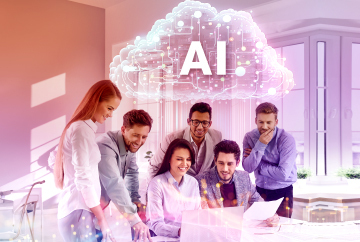Along with a surge in demand for new skills, they are battling 50 to 70% employee turnover and it is taking 18% longer to replace an employee than before the Covid-19 pandemic.
The cost of replacing an employee can range from one half to two times the employee’s annual salary. Today, job loyalty is an exception and a whopping 75% of employees are active job-seekers, according to Michael Page Talent Trends 2023 India study. Globally, quiet quitting or job change is a continuation of a long-term trend and likely to continue in the years to come, argues an article in Harvard Business Review. The pandemic exacerbated the talent reshuffle trend, and now, organizations are also dealing with the need to manage expectations of remote workers and transition smoothly to a hybrid workplace.
Savvy organizations are beating the odds by employing talent analytics, an approach that equips them with insights into EX (employee experience), talent deployment, dynamic capability building and behavior patterns that can predict talent engagement levels/ quiet quitting/ burnouts and turn it into a proactive retention strategy.
Adaptive Talent Analytics for Transformational Goals
There has been a sea change in employee expectations - traditional employees motivated by things such as compensation, interesting colleagues and inspiring leaders are becoming rare today. Today employees are becoming more demanding, they seek the freedom to choose their work, multiple career paths, ongoing career development, shared values, and an enriching environment.
Organizations are hard pressed to cater to the changing expectations with traditional approaches. Intelligent talent insights into talent deployment, skill or competency gaps, flexibility to work on short gigs and flexible career choices are becoming important considerations to engage with the employees today. Apart from this great EX, well designed wellness programs, ensuring proactive measures to avoid burnout and sensing employee sentiments continuously empower HR teams to plan proactively, get more purchase from their budgets and deliver good business impact. Although AI analytical models, bots, and GenAI are facilitating many of these advancements, most organizations are currently at various stages of this journey toward optimizing operations and delivering increased value to both the business and its employees.
Indian companies are slowly but surely embracing analytics in HR functions with varying degree of maturity. A Deloitte study finds more than 24% organizations at an advanced stage of adoption with initiatives tied to strategic outcomes and are being driven by CEOs and/or COOs and not just the CHROs.
A data analytics led strategy closely aligned with HR work areas, data-based decision support and leveraging technology to bridge the gap between employee expectations and business needs will help organizations meet employee aspirations and organizational objectives simultaneously.
Talent analytics is driving transformation in many ways, some important ones are:
Effective Talent Deployment — By utilizing data analytics to forecast demand patterns for current and future business requirements, alongside insights into employee aspirations and skill competencies, HR teams can proactively strategize talent deployment. Additionally, this approach will assist Talent Management teams in designing skilling programs that align with both business requirements and employees’ career aspirations. This ensures optimal deployment of talent within the organization, thereby minimizing talent wastage and revenue leakage.
Dynamic capability building — Talent analytics is revolutionizing capability development by employing 'open learning' frameworks and utilizing data analytics to forecast upcoming technology skills and demand trends. Analytics also supports Talent Management teams in efficiently allocating and utilizing their training budget/ resources.
Democratization of career choices — Enabling employees to democratize career decisions and empowering them to define personal growth trajectories that align with their career ambitions and interests will increase employee engagement. Tailored learning paths are customized for each employee, addressing their specific skill and competency gaps. Talent Management teams can significantly enhance employee career development by empowering them to choose their career paths and curate personalized learning journeys based on their career aspirations. When coupled with tracking mechanisms that link achievements to organizational goals, this approach creates mutually beneficial outcomes for all stakeholders involved.
Internal Gigs — Connecting internal gigs with rewards program offers every employee the chance to take on short-term assignments. These gigs allow employees to test and apply newly acquired technical skills or utilize their free time productively. Engaging in internal gigs enriches employees' experiences, and with the incentive of a rewards program, it ensures they are duly recognized for their contributions. This setup could prove mutually beneficial for both employees and the organization by potentially boosting overall productivity.
EX (Employee Experience) — EX is a top priority on the CHRO’s agenda, recognized for its potential to strengthen employee pride, enhance retention, and positively impact the employer brand. Key to achieving outstanding EX are service ‘on-demand’, self-service options, hyper customized experiences and smart AI enabled processes. Despite its importance, only a small fraction of business leaders feel adequately prepared to tackle EX, with Deloitte reporting that 84% see it as crucial but only 9% are ready to implement them.
EX encompasses the entirety of the employee journey, spanning from recruitment to departure, and revolves around cultivating a culture built on trust, inclusivity, and opportunities for growth. It plays a pivotal role in driving employee engagement, longevity, and performance, while also influencing customer satisfaction and loyalty. According to Gallup, companies with highly engaged employees surpass their competitors by 147% in earnings per share, with EX identified as a primary driver of engagement. McKinsey's research further highlights that optimizing EX can elevate customer satisfaction by up to 10% and reduce employee turnover by as much as 40%.
Wellness — Employees no longer live in a world where work dominates their lives, relegating everything else to a secondary role. Organizations are now dedicated to creating workplaces that prioritize their employees' well-being above all else. The concept of wellness has evolved significantly beyond basic medical insurance, encompassing all aspects that contribute to an employee's overall health, as defined by the Global Wellness Institute.
In line with this comprehensive approach, organizations are adopting AI-driven tools to predict and prevent burnout, effectively manage workplace stress, and provide timely wellness prompts through specialized apps. Analytics plays a pivotal role in uncovering connections between wellness efforts and factors such as employee engagement and motivation.
Employee Engagement — Talent analytics is helping identify employees at risk of attrition. Six in 10 employees are quietly quitting causing a loss of 9% of the global GDP, according to State of the Global Workplace. At the same time, predictive analytics is helping identify employees likely to thrive in the organization and better prepare for specific roles and responsibilities.
Performance Assessment — Utilizing talent analytics through data-driven systems enables organizations and employees to monitor and enhance performance proactively, ensuring adjustments are made to avoid unexpected outcomes during appraisals.
From the Back Seat to the Front
The transformed HR organization now collaborates as a strategic partner with the CEO’s office, actively propelling organizational growth through data-driven insights and the utilization of an AI-empowered workforce. No longer confined to a supportive role, HR plays a crucial role in shaping the organization's strategy.


